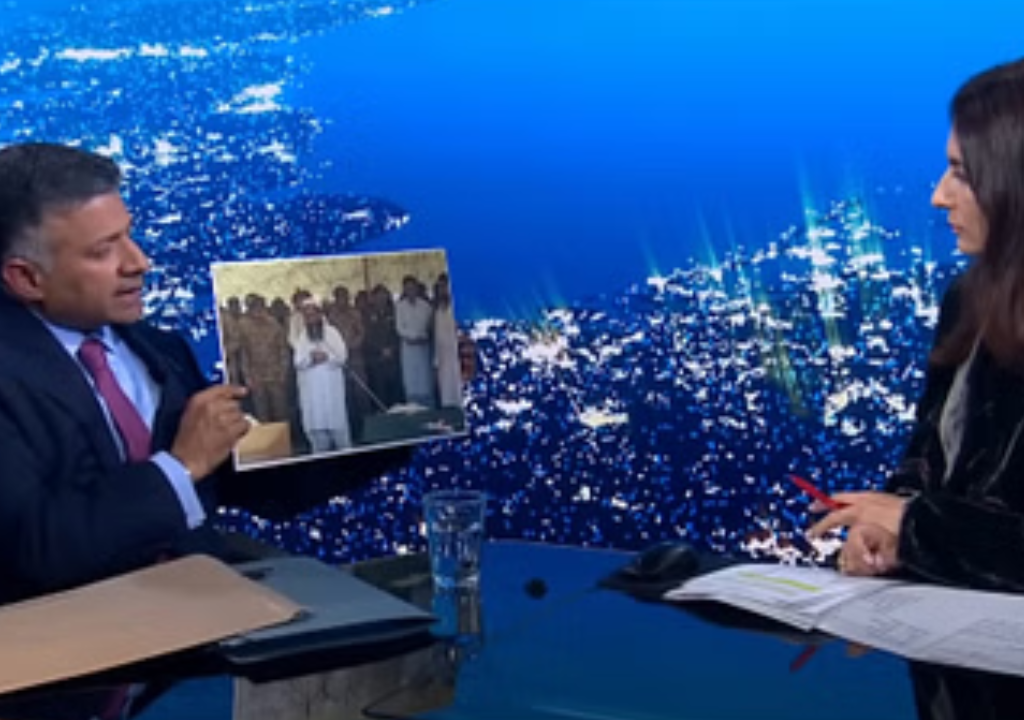India has once again brought global attention to the issue of Pakistan sponsored terrorism, this time with compelling visual evidence. In a recent interview with Sky News, Indian High Commissioner to the UK, Vikram Doraiswami, revealed a photograph showing Pakistani military officers standing behind a US-sanctioned terrorist, Hafiz Abdur Rauf, during a funeral for militants killed in Operation Sindoor. Shared simultaneously at a press briefing in New Delhi, the image is being cited as clear proof of Pakistan’s deep state support for terrorism, reinforcing India’s long-standing position that terror outfits operate with official backing from the Pakistani establishment. This new revelation intensifies the global spotlight on Islamabad’s complicity in nurturing and legitimizing cross-border terrorism.
The Image That Speaks for Itself : Pakistan Sponsored Terrorism
Speaking to Sky News, Doraiswami revealed a poster-sized image from the previous day’s funeral. It showed Hafiz Abdur Rauf, the brother of Masood Azhar—the founder of Jaish-e-Mohammed (JeM) and a UN- and US-sanctioned terrorist—standing alongside Pakistani military officers. Behind him were coffins draped with Pakistani national flags, a move widely interpreted as a state endorsement of the deceased terrorists.
Doraiswami stated,
“This person is a sanctioned terrorist under the American sanctions regime. His name is Hafiz Abdur Rauf. Look who is behind him—Pakistani military. If you’re going to give terrorists state funerals, what does that make of your system?”
The statement was direct, damning, and clearly meant to counter Pakistan’s narrative that it is a victim of terrorism rather than a perpetrator.

Backdrop: Operation Sindoor and the Pahalgam Attack
The explosive revelation follows India’s coordinated airstrikes under Operation Sindoor, launched in retaliation for the April 22 terror attack in Pahalgam, Jammu and Kashmir, where 26 civilians were killed. In response, India carried out precision missile strikes on nine terror camps located in Pakistan and Pakistan-occupied Kashmir, including the Jaish-e-Mohammed headquarters in Bahawalpur.
One of the key targets in the Bahawalpur strike was Abdul Rauf Azhar, a senior Jaish operative and Masood Azhar’s brother. India’s ruling party shared a graphic of Abdul Rauf with the word “Eliminated” stamped across his face. Azhar is known to have played central roles in the 1999 IC-814 hijacking, the 2001 Parliament attack, and the 2016 Pathankot airbase attack.
Historic Context: Pakistan sponsored terrorism
Doraiswami also took the opportunity to underscore that Pakistan’s history of terror complicity is not new. He cited previous instances where India attempted diplomatic cooperation only to be met with duplicity. One such example was India’s unprecedented decision in 2016 to allow Pakistani investigators into the Pathankot airbase after a terror attack. Despite this goodwill gesture, there was no reciprocal transparency or accountability from Pakistan.
He further pointed out that in the 2008 Mumbai attacks, India shared extensive dossiers, including call records, GPS data, and photographic evidence linking the terrorists to Pakistani handlers. However, Pakistan either ignored the information or deliberately misused it to obfuscate the role of its deep state, including the Inter-Services Intelligence (ISI).
Why This Photo Changes the Diplomatic Landscape
This photograph acts as a rare, visual confirmation of Pakistan’s military honoring a known terrorist. Internationally, most evidence of state-sponsored terror has relied on intelligence reports, statements, or intercepted communication. A photograph—clear, dated, and publicly presented—offers tangible proof that can be shown to governments, media, and global institutions like the United Nations Security Council.
India is now expected to share this evidence with global allies and push for renewed sanctions and diplomatic pressure on Pakistan. The image may also find its way into forums like the Financial Action Task Force (FATF), where Pakistan has previously been grey-listed for failing to curb terrorist financing.
Links Suggested: Digital India and Cyber Security: Balancing Innovation and Protection
India’s Strategic Messaging
By making this evidence public during a high-profile interview in London and simultaneously at a press briefing in New Delhi, India has taken its messaging global. The image wasn’t just intended for domestic audiences but for Western media, policy-makers, and diplomatic communities—especially in the UK and the US.
This is part of a broader Indian strategy following Operation Sindoor, where the military action has been paired with diplomatic offensives and media transparency to make the case against Pakistan airtight.
What’s Next: Legal and Diplomatic Pressure
With Abdul Rauf Azhar eliminated and photographic evidence of Hafiz Abdur Rauf’s ties to Pakistan’s military now public, India is likely to press the case for international sanctions, criminal designations, and further diplomatic isolation of Islamabad.
Legal experts believe that such visual evidence may also aid in reinforcing UN Security Council counter-terrorism mandates, especially under UNSC Resolution 1373, which calls on all countries to “refrain from providing support, active or passive, to entities involved in terrorist acts.”
Conclusion
The Pakistan sponsored terror proof revealed by Indian envoy Vikram Doraiswami is more than just a photo—it is a snapshot of an entire system of state-sanctioned terrorism. As India builds on its military precision under Operation Sindoor with diplomatic transparency and strategic exposure, it shifts the narrative from accusation to irrefutable evidence. The question now is not whether Pakistan sponsors terrorism, but how the international community chooses to respond to the proof laid bare before it.

